FergWorld : Travelogues & Photos : Simuflite Diary

By Ryan Ferguson, © 2001-2005
This is a semi-complete (okay, might as well call it 'incomplete') journal of my Simuflite training experience. I apologize for the low quality of some of the photos; these were taken with my integrated cell-phone camera, which works okay in well-lit rooms, not so great in the shadows.
Simuflite & the HS-125 type rating
6/07/05: (Day 1) I've arrived.
Actually, I arrived to DFW yesterday, but this is my first day of training at Simuflite so this is really 'Day 1.' The facility is located on the southwest corner of DFW on W. Airfield Drive. American Airlines fills the skies and the ramp here.
I'm due here at 8:30AM for check-in, so I arrive 30 minutes early (via hotel shuttle) to make sure I'm not late. Walking in, I meet my account rep and, surprise! Two other pilots from my company, both here for Beechjet training (one initial SIC, one recurrent.) We have a brief pow-wow while we get our bookbag (a black nylon 'Simuflite' logo'd jobbie), nametags (all the better not to get kicked out by security for not having them,) then disperse to our respective classrooms to begin ground school.
CAE Simuflite does an excellent job of impressing you as you arrive and enter their facility. It's a pretty big building (four stories, and fairly wide/deep from all sides) which is very modern and aesthetically pleasing in its appearance. The antechamber features a huge glass wall which allows visitors and clients alike to gaze upon one of the full-motion sims (this particular one a Lear 35/36 simulator) which glides around like a drunk, glued-to-the-ground spider on tall hydraulic actuator legs. From ground level, you look up to the top of the sim cab about thirty feet above you. Pretty impressive.
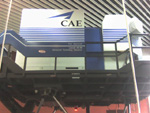 |
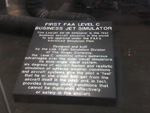 |
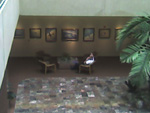 |
| Lear 35/36 sim which is prominently displayed in the main entrance foyer. |
Huh, that's interesting. |
Looking down at the first floor (very grainy.) |
The floors are all polished marble, the furniture all leather, and everything just feels big, classy, and luxurious. (A stark contrast in lifestyle for most of Simuflite's clients, I'd say!)
Then, you enter into a large solarium which serves as a traffic hub for the entire center. The skylight at the top of the four-story hall highlights a twenty foot waterhall on the east side of the room. The soothing sound of flowing water provides a satisfying 'white noise' sonic background. Clear glass guard-rails line all four stories. Entrances to the sim bays are on the north, south, and west wings of the hall. You'd almost expect to hear parrots chirping and flying betwixt some tropical foliage or other, but that motif is cut short by the nattily-attired instructor pilots walking around in crisp three-piece suits with matching ties, and tons of aviation art. The walls of all four stories are adorned with beautiful business aviation imagery. On the first floor, a series of nicely lit historical airplane watercolors are displayed for perusal, along with comfortable chairs and a large-scale model of Simuflite's G-IV sim cab.
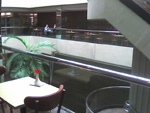 |
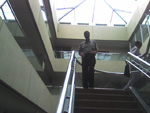 |
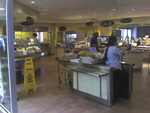 |
| The second floor at CAE Simuflite. |
Movin' on up, to the sky... |
Cafeteria... really good food here. |
On the second floor is an aviation library (complete with a librarian, who knows what you mean when you say "TFE-731-3R-1H" instead of "Huckleberry Finn") and a cafeteria. The second floor also has a hang-glider simulator (which I wound up flying many times during my stay), a TV/lounge area, some internet computers, and snack/soda machines. Client services is also on this floor - they'll send a fax for you, or handle some issue with your paperwork for you, get you free tickets to a baseball game or who knows what else.
The third floor is all classrooms, divided up by airplane. All of the Hawker 700 stuff was on the third floor located near some other Raytheon products (King Air.) The fourth floor is mostly offices - (I never made it up there, actually.)
On the second and third floors, there are exits from the main hall area into the sim bays. My Hawker 700 sim would be located in the second floor "West Wing" sim bay.
 |
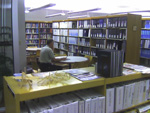 |
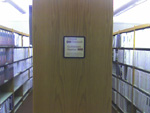 |
| The library even has issues of Aviation Safety and IFR Magazine. |
An all-aviation library - kinda cool. |
Turn RIGHT for Hawker. |
The format for the training is simple: week one is ground training, week two is sim work. You're expected to study each night, and there'll be one day off between the ground and sim sessions. Other than that, this is, for the most part, a do-all-the-time proposition. You don't have much of a chance to do anything other than absorb your airplane.
I find my classroom. At each of the four seats is a large pile of training materials, many of which I'm already familiar with, thankfully. On the walls are large diagrams of the Hawker cockpit; side panels, overhead, circuit breakers, and so on. A nice video projector is attached to the ceiling which is giving us a Powerpoint-powered 'Welcome' message. Jeremy, our instructor, is seated at the front of the classroom and is sure to greet each of us by name, and shake our hands as we walk in the door. At 9:00AM sharp, we start. The syllabus calls for us to start by going over the schedule, which is exactly what we do. Day one of ground school begins.
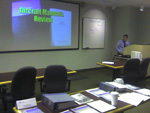 |
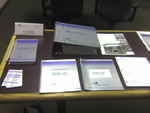 |
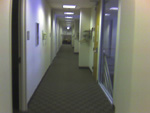 |
| The classroom - instructor Jeremy at front. |
All you've gotta do is memorize THIS in two weeks. |
West Wing sim bays. |
06/12/05: (Day 6) Just one more day of ground, then it's into the sim.
Most of that stuff you hear about "drinking through a firehose" is right on the money. There's a ton of stuff to assimilate about a turbojet airplane in 7 days. Luckily, I had access to most of the Simuflite training materials before I attended school, so many of the topics were "highly detailed reviews." Two beers at dinner tonight. Two of the other pilots in my class sat with me as we ate and drank, mostly silent, zoning out and staring at the walls. Saturation point.
Still, it's been a highly enjoyable experience. This is training at its highest level - much more comprehensive and authoritative than anything I've experienced in general aviation. One thing I appreciate about Simuflite is an emphasis on real-world knowledge. The instructors' main goal is to help you operate in the real world, rather than focus on useless minutiae. Sure, you've got memory items, limitations, and systems to memorize. But "green arc" is a sufficient answer for "normal oil pressure range." No attempt to force SOPs on anyone, either... if your company has a different practice, you can use it here.
6/19/05: (Day 13) I feel like I live here. Honestly.
I know all of the front desk folks here at the Amerisuites by their first names. I know most of the shuttle drivers. I know each and every convenience store within walking distance, and I know the Grapevine Mall pretty darn well, too. (I also know to avoid the local Whattaburger - oooaaahh, my aching gut.)
I arrived at CAE Simuflite DFW on June 6. As I write this, we're just 45 minutes shy of June 19. The checkride is June 21. It seems like I'll never get home to my wife and daughter.
Today was "cold weather" day in the sim. Various sundry electrical failures (inverters, buses, alternators and generators), icy runways, lots of twists of the TKS egg-timer, engine anti-ice failures. Oh, and of course the ever present rejected takeoffs, V1 cuts, second segment climb flameouts, and engine fires. Fun stuff. (Well, it was fun a few days ago, but now this stuff is just getting long in the tooth.)
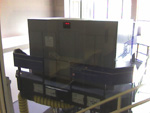 |
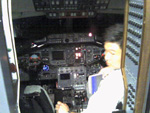 |
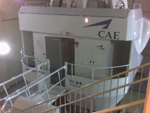 |
| Here's our little box - the HS125-700 sim. |
My sim partner, Eddie, on the right. |
Challenger 601/604 sim. |
Perhaps the most fundamentally different concept in most turbojet airplanes, and the one that's been hardest to "train out" of me as a piston driver, is that only rarely does an in-flight emergency require any immediate action other than flying the airplane. This is especially true at low altitudes.
For example, say you lose #1 at V1. This is a "ho-hum" event because all you're gonna do is pitch to the command bars (12 degrees nose up in Go-Around mode), override the APR if necessary, and retract the gear at positive rate. Pitching into the bars automatically gives you V2. If you feel like it, and you probably will, use aileron trim to ease the control pressures. If the engine's on fire, you'll probably want to isolate the warning bell, just because it's so loud you can hardly hear yourself think, and it's causing your passengers to wet their pants.
Oh. And leave your feet on the floor. Rudder bias (which is a function of engine bleed air) will actuate the rudder for you, and apply the proper amount of pedal pressure.
For now, you're done. There's no flurry of activity in the cockpit. The PNF will make a leisurely call to ATC and declare the emergency. The PF doesn't call for checklists, doesn't let loose a bunch of cockpit-kung fu, he simply flies the airplane. V2 up to 1500 feet AGL.
If the density altitudes are low, and/or you're light, you'll zip right up to 1,500 feet. If not, it may be a rather ponderous climb at 500-700fpm, using a good chunk of your 5 minute APR window to get there. Single engine performance can be surprisingly poor.
At 1500 feet, the PF accelerates to V2+6 for single-engine flap retract speed, calls for Flaps 0, and maybe considers taking a radar vector for the ILS. As you do this, accelerate to Venr.
The entire time this is taking place, #1 might be burning a bright, blazing trail in the night sky, but you're not worried about much in particular except keeping the stars above and the streetlights below. (More than likely, in the sim, you're solidly in cloud and the departure airport is reporting 200 and a quarter.) Now, you finally call for the Engine Fire checklist, shut the mother down if it's not producing power (and/or you don't need it), and complete the engine shutdown checklist.
It is, at best, a leisurely pace. If the engine falls off its titanium engine mounts in the process, so much the better. Either way, the problem is contained beyond the pylon, you're doing fine on the good remaining engine, and you don't care a lick about that sick dog.
This is a fundamental shift from how this sort of training was once conducted. Once upon a time, a V1 cut would cause the flight deck to descend into a frenzy of activity right after rotation. It seems that this burst of activity combined with the inherent weaknesses of human memory often made an emergency worse. Hence the change.
Another change to which I've become accustomed is the greatly-increased role which the autopilot plays. It's permissible (encouraged, actually) to fly most of the type checkride using Otto. Coming from a GA flight training background, this was hard for me to initially accept. I probably spent too much time trying to learn how to hand-fly the sim. (The real airplane is much easier to fly.) Today it finally "clicked" for whatever reason, when I learned to simply trim off the control pressures and stop nudging the yoke! Just set it and park it. It doesn't fly like an airplane, it flies like a sim, and I had to learn how to fly the sim.
The easiest way to set power in the jet, incidentally, is with fuel flows. This is an instantaneous readout of power, vs. attempting to set power with %N1. It takes a while for that big fan to spool up or down. In the 700, setting 750pph/side is a great way to get 200KIAS for training maneuvers and approach intercepts. 400pph/side is a good non-precision approach descent power setting (returning to whatever was set prior to the descent when levelling off.) Dive and drive is king here. Attempting to fly a virtual glideslope via derived VDPs is discouraged. Too much thinking involved, too great a chance for errors.
Single-engine fuel flows? Just double what you had with two. If 750pph/side gave you 200KIAS, 1500pph (single engine) will give you pretty close to the same.
Speaking of those emergencies again. Got a great piece of advice from a grizzled old aviator - "the only real memory item you need to worry about on those checklists is 'EMERGENCY O2 MASK - DON'." He has an excellent point; smoke in the cockpit, or depressurization is probably the only time you need to race to get something done, and that something is to get your mask on post-haste. Everything else can be dealt with in turn.
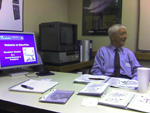 |
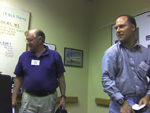 |
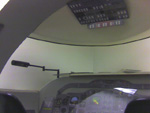 |
| IP Dick P. Want to hear some interesting stories? This is your guy. |
Fellow victims, er, classmates, Jim and Mike. |
Our Cockpit Procedures Trainer. |
One of the maneuvers which must be accomplished per the PTS is an approach with a circle to land. We're flying an NDB approach (groan) with a circle to land just beneath an overcast and just above our MDA. If you disappear into the clouds, back 'round you go, and of course, per the AIM you must miss starting with an initial turn towards the landing runway. This results in a big 360 back onto the published missed approach. It's something you really want to avoid, because the chances for checkride-busting errors are everywhere.
Anyway, this is far more challenging than it would be in a real airplane, because your view at 90 degree angles in the sim is limited and you can't see the airport for much of the circling maneuver. As a result, part of the circle is really a "dead reckon" maneuver. We cheat and use the RMI to tell us when we're abeam an on-field VOR, and can turn in. Additionally, this must be hand-flown (Otto must stay off below 1000AGL unless he's coupled) and it's a heckuvalotta work to stabilize that sim and hold altitude while looking outside for the lead-in lights. This being a Level C simulator, the FAA must individually approve each approach used to meet the PTS requirement for the circle-to-land. So we know this is how it'll go on our checkride (a bonus.)
My sim partner and I have each crashed the sim twice. The first time was a great learning experience. Our instructor that day was stacking emergencies up on us; we were single-engine after dealing with an FCU failure on the #1 engine, flying a VOR/DME approach when #2 (our only good engine) caught on fire. As we were above 1500 feet I automatically called for the engine shutdown checklist before I realized how stupid that idea was, so we continued. We broke out at minimums to find nothing, and realized we hadn't activated the runway lights. I flew a very low downwind while we worked that out, lost sight of the runway as it slid past the edge of the side monitor, and tried to guess the right amount of time to turn inbound. I guessed wrong and was much too high and fast to make it in safely, but elected to continue since we had an engine fire on our only operative engine. Got a big sink rate going and couldn't negate it at the flare. I crunched it in at 2.8G. OUCH!
I'll try to sum all this stuff up when I get the sam hell outta here. I am ready to go home in a big way. 17 days is wayyy too long to be away from my family.
6/20/2005: (Day 14) Today was our last day of "freebies" in the sim. We finished up with our "hot weather" day - 108 degrees F, a loaded airplane, and high DAs. Single engine climb performance is horrendous and there's no leeway for error to fly above V2 (normally keeping V2+10 provides a nice rate of climb on "average conditions" days.) I must say, as a crew Eddie and I have really come together. Rejected takeoffs are a two-man affair as the PF must operate the tiller below 80 knots while the PNF holds the "tops" (yoke). Also, to deploy lift dump (which lowers the flaps to 75 degrees) requires the flap handle to be in the 45 degree position. This means the PNF is busier than the PF on normal and rejected takeoffs as APR, T/R stow, gear, and flaps are all his responsibility. The only way to safely reject a takeoff is for the two-man crew to work together.
Lift dump is amazingly effective. Those Brits can really build a hell of an airplane. The lift dump provides more drag than deployed T/Rs right after touchdown. In fact, by the time the T/Rs have been unlocked and are ready to deploy you're usually decelerating through 90 knots and can only blast them in reverse for a few seconds before you come up on the 60 knot max T/R reverse thrust limitation. On wet or icy runways, however, the T/Rs are really nice to have.
Since every sim training event is designed to be the worst case scenario, it only makes sense that we'd have to deal with wind shear on our "hot and heavy" day so that our performance would be minimal. My first wind shear event occured just after my second takeoff. The procedure is simple: pitch up until you get to stick shaker, bring both thrust levers forward, and call for APR override (which gives an add'l 180 lbs. of thrust per side) from the FO. Leave it there and hope you can power your way out. Seems to me the scenario is designed so that it'll only work if you do things pretty close to perfectly. I hope I never experience this in the real airplane, but if I do, I have a gut feeling that the sim's wind shear model is pretty accurate.
Of course, it's only logical that right after powering out of the wind shear you'll lose an engine. Oh, and the weather's crap now, too. Fly direct to such-and-such fix and hold, and while you're in the hold, shut down and either relight or secure the engine. All pretty straightforward stuff, with an emphasis on precise attitude flying to get the necessary performance.
Eddie and I felt pretty good after wrapping this up (our practice checkride is tomorrow) and Mike, our instructor, asked if there was anything else we'd like to try. I spoke up and asked for a rudder-bias inop V1 cut, as I'd heard the airplane was difficult if not impossible to control without the pneumatic rudder assist. Now, granted, I knew it was coming, but I was able to keep the airplane reasonably straight with a huge gob of right rudder. I had more strength to give in my leg, but not much. It was a heck of an effort to fly the airplane out holding that rudder in. I'm glad this system is so reliable, because I don't ever want to be without it.
We were done with our session and had about 15 minutes of "play" time available to us. This is time we can use for whatever we like, usually things that are not involved in the normal course of training. We are given the green light to experiment without fear of retribution (i.e. comments in the training file.) Mike said, "Here's a humdinger," loaded us up at JFK, and cleared us for takeoff. Humdinger was an understatement. In the first segment climb, the airplane yawed violently left and then began a rapid rate of roll. In less than three seconds it was over - we were upside down on the departure runway. "Hanging" in our straps, I looked at the panel to figure out what went wrong - both engines were indicating takeoff power at impact, and the MWS (master warning system) was blank and silent. After scanning for a good five seconds, I found it: a small green "reverser" light illuminated just above the pedestal. Uncommanded thrust reverser deployment. Nasty!
The recovery method for this emergency is something piston twin drivers are familiar with: the first step is to close both throttles to reduce the asymmetry. If you have time, scan the panel; if one of the T/Rs shows deployed, bring up the opposite power lever, and simultaneously pound the "Reverser inop" button (which is not intuitively labeled, do you think?) which reroutes bleed air to the pneumatic latches to restow the T/R. Now you're on one engine, hopefully the T/R will stow, and you can bring back the power. The whole sequence is lightning fast. I felt grateful that Mike had shown me this abnormal, as our Hawker back in Florida is equipped with T/Rs (many are not.) I had a chance to practice this a couple of times, which hopefully ingrained it into memory successfully. For sure, that is one of the nastiest failures you can experience in a Hawker. After the initial failure you have about one second to determine whether the yaw is going to stabilize or get worse. In any normal engine failure scenario, the yaw shouldn't be too excessive provided you're at or near V2. If the roll starts to couple with the yaw, you've just got to be ready to slam those levers back and take what you've got in front of you, or if you've the presence of mind, to emergency stow that T/R. I'm glad this isn't on the checkride. Frankly, the odds are stacked heavily against the pilot if this were to happen on takeoff in the real world.
More failures are stacking up on top of each other, which they can tend to do in certain cases. For example, we had a rapid decompression today at FL350; don the masks, close the main air valves, open the flight deck heat valve (aux bleed), pound the cabin notices switch, and begin an emergency descent - throttles to flight idle, roll 30-45 degrees, pitch for Vmo/Mmo, and start dragging that airbrake on as you get close to the barber pole. This is one of the few emergencies that requires a crew response consisting of almost purely memory items. In the process, we lose hydraulic pressure (all of it - meaning we have to use emergency brakes, which are not anti-skid, too) and have to pump down the gear and flaps. Once you pump down the gear, you can't get it up again, so you really don't want to have to fly a missed. Since the airplane seems healthy, we elect to fly a little further to an airport reporting 600 foot ceilings to reduce the chances of a miss.
The rest of the day was the usual single engine ILS', NDBs/circle-to-land, approaches to stalls, and steep turns. The checkride won't be nearly so involved as the above - it's just your plain-jane vanilla ATP ride, per the PTS.
6/21/05: (Day 15, type checkride) So. I wake up. Finally, checkride day. Honestly, I'm not terribly worried about this ride. The training has been good, my sim partner is competent, and I'm studied up for both the oral and the flight.
A type ride at Simuflite is a fairly long event. Not including a one-hour break for lunch, we start at 10:00 AM, and the schedule calls for us to be finished at 7:00PM. (We ended up using that entire time block.) I arrive about an hour early for one last quick refresher, and to add some more notes into my bound checklist. (This is fair game on the oral.)
I meet with Eddie. He's nervous, really nervous. He told me as the weeks progressed that he'd be a wreck on checkride day, and that turns out to be a pretty apt description.
This being my first type ride, the following things are new to me: 1) Being quizzed and checked as a crew from the beginning, and throughout, to the end. 2) Being stressed more for my sim partner, worried about screwing something up that would actually bust him. There's a high level of trust involved in this, because in many cases the guy being checked in the left seat is relying on the guy in the right seat to properly perform engine shutdowns, run checklists, set up and brief the approaches, and do a lot of other stuff with very clear black and white 'bust' lines (heh!). It's the job of the PIC to 'supervise' and make sure they're done correctly. The truth is, the FO has a more difficult job during training events because he's strictly dealing with emergencies, checklists, and setups, while the captain is strictly dealing with flying the airplane (and NOTHING else!) Yet, the FO isn't on the hook for anything while the other guy is being checked. It's quite different than the checkrides I've taken in the past, in which everything was done single pilot, and there was no second crewmember to help.
After some brief paperwork issues we start on the oral. The format is to alternate the questions between Eddie and I. The examiner, Nick, is friendly but also has the signature chiseled look and efficient mannerisms which almost invariably denote a former military man. I silently hope he's not low on his bust quota this month as he begins doling out the questions.
Which bus powers the APU? Which contactors are open when the Battery Isolate switch is used to select one of the two main batteries? Which bus is fire bottle #1 powered by? Fire bottle #2? What is the function of the Bus Tie switch? How many volts are batteries one, two, three, and four? The standby inverter is how many vA? What are the memory items for an engine fire? For a double generator failure? (For the record: 1. Panel lighting to standby. 2. Batt switch to 'Emerg.' 3. Verify Standby Inverter is armed and 'XE Fail' annunciator is out. 4. Power levers - reduce by 50 deg. ITT. 5. EECs to 'Manual.' 6. Load shed to maximum extent possible. Remember to turn off galley power!) Thrust reverser actuation limitations? Brake limitations? Rejected takeoffs above 90 knots? Function of the 2,300 PSI pressure maintaining valve? The pressure reducing valve? The full flow relief valve? At which PSI does that valve relieve hydraulic pressure?
This line of questioning continues for a couple of hours. Eddie relaxes as the oral progresses and finishes strong.
The oral complete, we head for the sim. Again, we're being checked as a crew, so Nick briefs us on the ride and what to expect. We're going to fly two identical profiles; one for Eddie, one for me. We'll depart JFK, fly a SID to a holding fix northeast of the airport, and perform our airwork there (steep turns and approaches to stalls.) We'll head to LGA for approaches and end up at JFK again at the end of the ride.
Eddie decides to go first, so I'm sitting in the right seat performing all of the tasks of an SIC. When you're taking a checkride in a sim, it must be treated like a real airplane in every respect, from the startup to shutdown. The examiner may not double your groundspeed to speed up a leg, nor may he reposition you laterally or vertically. So from the get-go, we climb into a totally dark cockpit and use our flashlights to begin the "Before Starting Engines" checklist.
For type ratings, you're judged by the ATP PTS, so it's basically just an ATP checkride. It's worth noting that you're being judged not only for your ability to stay within PTS standards, but (more importantly, in fact) for your CRM. Bad cockpit procedures can bust you here, even if the airplane doesn't stray outside the bounds of the PTS and the outcome of the maneuver is never in doubt. Since we've been working together as a crew for eight sim sessions, this is second nature for us at this point.
Now, I could bore you and repeat the rides twice, but I'll just sum up Eddie's ride and then tell you how it went for me. In short, he flew beautifully. He can really hand fly that sim like nobody's business, and he passed easily. I was happy for him, and proud. (Also, VERY relieved that I didn't do something to screw him up, like load in the wrong freq on a radio, or give him the wrong altitude on a plate.)
My turn in the left seat. I call for the Before Start checklist and we fire up the APU. The fire bell rings out - APU fire! Memory items are easy here. Shut down the APU and wait ten seconds. If the fire bell does not deactivate by that time, fire your one (and only) fire bottle. We turn off the APU, get it back (Mr. QuickWrench fixed it) and fire up the engines. I get a hot start on #2 (which is started first) and a hung start on #1. The hot start is taken care of by shutting the HP cock (high pressure fuel valve - gotta love the 'cocks' - it's Brit terminology) and letting the starter motor for another twently seconds or so as the ITTs wind back down. The hung start is no big deal, we don't get any N1 indication so we never introduce fuel and shut off the starter. Voila, We're done with the start abnormals. We get our clearance - which essentially involves turning to a heading after departure, climbing to 3,000 feet, and intercepting the JFK R-044 outbound - and taxi out.
The rudder bias, EEC (Electronic Engine Computer), engine anti-ice, and APR (Auxiliary Power Reserve) checks are completed while we're holding short. Everything's working okay, for now. (APR is armed before every takeoff. It bumps the available static thrust up from 3,700lbs./side up to 3,880. Not much, but it could make the difference in wind shear or OEI scenarios. Arming the APR means that when a 5% difference in thrust between the two engines is detected, APR will automatically activate.)
I give a takeoff briefing - any abnormals, lights, or weird feelings below 80kts, and we'll abort. Between 80kts and V1, we'll only abort for engine failure, any fire, or loss of directional control. Above V1, we're committed to takeoff and will work on the problem in-flight, above 1,500 ft. AGL. This'll be a Flaps 15 takeoff. We're going to intercept the yadda-yadda radial, etc.
Cleared for takeoff, we roll out onto runway 13R. The first takeoff of the day is a great example of how a crew works. I use the tiller to control the NWS (Nosewheel Steering) and keep the pedals aligned with each other so small and gentle brake inputs can be made more equally. "You have the tops," I tell Eddie. He brings the control column back to about the midway position, as my right hand is on the power levers and my left is on the tiller. I bring the power levers all the way forward (from idle to the full power about 5 seconds) and release the brakes. "Arm APR and set time," I call. Eddie arms the APR and starts a countdown timer. We only have 5 minutes of APR available before we must turn it back off, should it activate.
"Airspeed alive, gauges in the green," calls Eddie.
We accelerate.
"80 knots, crosscheck," he says, and I bring my left hand up from the tiller to the yoke and say, "Checks, I have the tops." He releases the yoke and guards the flap lever. Now I'm steering the airplane with the rudder instead of NWS. I'm waiting for his V1/rotate call when the MWS (Master Warning System) flashers begin alternating, and the center annunciator panel lights up with numerous warnings. This is accompanied by a severe yawing moment. "Abort!" we both call.
I bring the power levers to idle. Simultaneously, Eddie brings the flap lever to the 45 deg. position. As this occurs, I bring my right hand to the airbrake (just to the left of the power levers) and pull all the way back until I hit a detent, then pull up and back. The first pull opens the airbrakes, while pulling up and over the detent activates "lift dump," which lowers the flaps to seventy-five degrees. Lift dump is unavailable unless the flap handle is in the Flaps 45 position, so Eddie's action on the flap lever is definitely required. I gently apply anti-skid braking with my toes and pop the thrust reverser piggybacks (which are mounted just forward of, and facing "down" from the power levers.) Two amber "Reverser Unlocked" lights illuminate just forward of the pedestal. About two seconds later, they switch to a green "REVERSER" indication, which tells me that the cascading translating assembly has opened sufficiently for a reverse thrust selection. Now I pull up gently on the piggybacks for reverse thrust, which helps us to decelerate.
"80 knots," Eddie calls.
"You have the tops," I reply, and move my left hand back down from the yoke to the tiller on the left side panel. Eddie grabs the control column again and keeps it in a neutral (upright) position. 80 knots is also a call to deselect reverse thrust, as you must be at idle reverse by 60 knots. Dropping the piggybacks down to their idle position spools them down to idle as the airplane decelerates through sixty knots.
As we roll to a stop, Eddie transmits to JFK tower: "Tower, Hawker 125. We've had to abort the takeoff roll. We need a tug, please."
One rejected takeoff down, two hours to go. Phew.
We taxi back (Mr. Quickwrench fixed us up again) and set up for another takeoff on 13R. The visibility's dropped down to 600RVR, or the distance of about three runway lights on either side of the airplane.
The normal takeoff is also a good example of a crew intermeshing and working together. After Eddie calls "V1, ROTATE" my right hand comes off the power levers - we're committed now, and I won't touch them again for awhile - and onto the yoke. I give the yoke a healthy, but smooth honk back to rotate up into my command bars, set to 12 degrees nose up ("Go-Around" mode on the Flight Director.)
"Positive rate," calls Eddie.
"Gear up," I reply.
"Gear up... " Eddie pauses as the gear thumps into the wells and the green/red lights extinguish one by one. "Gear indicates up."
We're quickly up through 400 feet. "400 feet," he calls.
"Flaps 0. Set climb power," I reply.
Eddie now brings the power levers back to 865 C ITT. The ITTs will continue to rise during the climb, so he'll make occasional tweaks as we climb out to keep the ITTs right at 865, which is an AFM limitation.
"Climb power set," he calls.
"Run the Afters, please." (Referring to the after takeoff and climb checklists.) Eddie disarms the APR, resets his clock, turns off the ignitions, engages the yaw damper and opens the Main Air Valves (a Brit term for pressurization bleeds) to the HP position. Up, up, and away we go.
All I've gotta do is fly the departure and keep the Flight Director up to date with the latest ATC instructions. Easy, breezy.
We intercept the JFK R-044 and climb in solid IMC up to 10,000 feet.
On a heading of 090, it's time for air work. Before that, we must perform an ICES check. The ICES check is much like a pre-maneuver checklist for airwork in piston trainers. I = Igniters on, C = Check and set Vref, E = Engine Synch OFF, and S = Stick Shakers, TEST. Since we won't ever actually stall this airplane, the stick shaker test in particular is very important - imagine actually pitching up and entering a stall rather than getting the shaker! The shaker activates approximately 7% higher than stall speed. Of course, we could use our AOA instrument, but I've found it to be more of a distraction than anything else during training. I don't pay much attention to it or the AOA index indicator on the glareshield.
We start with steep turns, which I brief. We'll do two 360s, one left, one right. Eddie will call out deviations from altitude and airspeed. I'll call for power in fuel flow increments. We'll aim to keep 220KIAS and 10,000 feet during the turns.
I roll in to 45 degrees of bank - "Add 200 lbs.," I call, and roll in 3 seconds of nose-up trim from the yoke trim switch. The key is to keep the apex of ADI airplane nestled into about a 4.5 degree nose-up attitude. As every pilot knows, steep turns require coordination of power, pitch, and bank. It's tougher to do in a 25,000 lb. airplane because when the ship begins accelerating in any axis, it takes a fair amount of opposite input to correct it and start trending in the opposite direction. Also, since it takes longer to spool up or down, it takes longer for power changes to "trend out" and truly take effect. The trick is to make power changes at the first sign of airspeed change, and to "wait out" the trend. Eddie makes callouts for me: "+20, decreasing. On altitude. +10. On altitude. Speed minus 3. -10, decreasing."
Steep turns complete, we move on to approaches to stalls.
Clean: power levers to idle, trim to keep 10,000 feet until 150 knots. At 150, the gear warning sounds (those Brits believe in VERY loud horns and bells), which I kill with an isolation button on the left power lever. This is also my cue to stop trimming to make my recovery easier. The goal is to maintain 10,000 throughout - from initiation to recovery. As I decelerate, I must raise the nose all the way up to approx. +15 degrees to keep from descending.
Eddie calls Vref. Just below that, I get the stick shaker. I bring the power levers full forward and maintain my attitude. Drop the nose 1-2 degree and you're guaranteed to get a nice descent which knocks you out of PTS contention. I roll in a bit of trim as the airplane powers out of shaker. At ref+20 I begin reducing power and keep pitching forward to maintain 10,000 feet.
The next approach to stall is the Takeoff config. stall. This is a flaps 15, gear up, 15 degree bank approach to stall with the same setup (idle power.) Finally, the landing config. stall, which we do at flaps 45, gear down, and 65% N1 (no descent rate.) These all go okay. Now, we get vectors to LGA for the NDB 22 approach.
ATC (Nick) radios us: "Hawker 125, turn right heading 250, descend and maintain 3,000 feet." Eddie acknowledges. I bring the power levers back to idle for the descent and kick the autopilot on. We're rolling out on the 250 heading when we get a TCAS warning followed by a call from ATC: "Hawker 125, crossing traffic ahead, caution wake turbulence." Of course, we can't see anything, we're solidly in the clouds. Uh oh, this is a setup for an upset recovery!
We don't have long to wait. We feel a brief buffet, then the nose pitches up wildly and we bank 30 degrees to the left. The proper recovery is max power, bank to 90 degrees, let the nose slice through the horizon, and recover to wings level as airspeed increases. We accomplish this without incident, although upsets always leave my head spinning - something about the instruments/monitors not agreeing precisely with the motion platform.
We set up for the NDB 22 approach. Eddie does all the hard work here; I simply fly the airplane. We're careful to set up for the miss (there's always a good chance of going missed on ANY approach during training) which involves flying a VOR radial to VERGE intersection and hold. At 3,000 feet, getting vectors to the IAF, I call for "Approach Checks." Eddie briefs the approach, sets the MDA in my the altitude alert window, sets the radar altimeter altitude on my ADI, sets Vref on my ASI (and his), turns the Igniters on, checks for fuel imbalance, turns off the Flight Deck Heat (aux. bleed) valve, makes sure my side panel is clear for NWS (nothing can block the tiller) and, of course, turns on the "Fasten Seatbelts" (Cabin Notices) sign. "Approach checks complete."
Nick the Examiner is no dummy. He's sure to fail my HSI so I can't use it to simply track a VOR radial which falls right on the NDB 22 final approach course. I still have my "strawberry," an ADF pointer on the HSI, and two dual-needle RMIs to work with, so this is not an issue.
We start the time at the FAF and head down to the MDA. At 2:00 minutes, the MAP, we see no sign of the airport and go missed. I activate 'Go-Around' mode on the FD, bring the power levers forward, call for flaps 15, and gear up at Eddie's "Positive rate" call. Eddie calls tower to inform them of our miss. At that precise moment, #2 flames out.
"#2 has failed," calls Eddie.
"Roger, close the bleeds, activate APR and declare an emergency," I reply. I punch the Cancel button for the MWS to dim the flasher. This is actually a rather calm time. We've been relieved of responsibility to do anything other than fly the plane back up to 1,500 AGL. "Also," I add, "ask them for a straight-out to 1,500 AGL rather than the published miss." I know, as I ask this, that "ATC" will probably say no and make us fly the published hold, but in an emergency in the real airplane we'd insist on getting a straight-out unless it was not feasible to do so for terrain or other overriding concerns.
"Negative, fly the published miss," comes the expected reply. I ask Eddie to set me up for the missed; I'm still concentrating totally on the six pack, maintaining V2. Performance is really bad today; I'm barely getting 300 fpm. But, the temps are quite warm and the airplane is loaded up, so this is not totally unexpected.
I keep the airplane nestled up into the command bars and make sure I keep my airspeed right at V2. This will give me the best possible climb performance. At 1,500 AGL, I accelerate to V2+6, which is Single-Engine Flap Retract speed, and call for Flaps Up. As we accelerate, I call for APR off. Now I'm pitching for Venr, which is single engine enroute climb speed. Venr is sort of a Vy speed, and V2 is sort of a Vx speed, for loose comparison. Finally, I can turn on the yaw damper and autopilot. I'm heading out to VERGE, which is 10.5 DME, and I've got about 5nm to go.
I glance at the two engine columns (FF, N1, ITT, N2) for the first time. #2 is indeed not producing power. I check right away for any fan or N2; if we have those, the engine is windmilling which means it may relight. If either N1 or N2 is stuck at zero, it's not a restartable engine. Both N1 and N2 are indicating, with N2 at about 10%, so I call for the engine shutdown and starter-assisted relight checklist. Eddie runs them while I fly.
Whenever we shut down an engine, it's always a two-man process. I start by bringing the power lever for the sick engine back to idle to verify we're shutting down the correct engine. No change. Per the checklist, Eddie calls, "Right HP cock, shut." I reply with "Guarding left, close the right." This is repeated with the right LP cock. Eddie goes about tripping off the #2 gen, closing the bus tie, killing the #2 alternator, engine synch, etc., etc. Finally he calls, "Engine Shutdown Complete." By this time I'm outbound for my teardrop entry to the hold. Since we've got N2, I call for the Starter-Assisted Relight Checklist. Eddie runs it, the engine starts up, and we get a vector out of the hold for the ILS RWY 4 at LGA.
This one is run just like before with the Approach and Landing Checks. We break out at minimums (seems every approach is always to mins in the sim!) and see the runway. I prepare to land when tower calls: "Hawker 125, go around, GO AROUND, equipment on the runway." Full power, I call for flaps 15, gear up at positive rate and we run the afters on the climbout. Looks like LGA isn't in the cards; a ground ops vehicle is stalled on the runway intersection. Damn them! On top of everything else, ATC calls to tell us they've lost radar contact. We're cleared direct to the JFK VOR for the full VOR 4L approach, circle to land 31R.
A word about circle-to-land approaches in the sim. They're DAMN hard, more of a dead-reckoning maneuver than a visual procedure. I felt that if I'd bust anything, this would be it. Since the monitors don't quite project a 180 degree view from the cockpit, you simply can't see your landing runway for much of the circling maneuver. You can't use the A/P, because it has an AFM limitation of &rt;1,000 AGL for uncoupled approaches. The cloud bases are always just above the MDA, so if you try to keep it a little high you'll probably pop up into the clouds, have to fly a big circle to get on the published miss and do the whole darn thing again. And of course, PTS calls for -0 ft. for MDA tolerance. So this is where I really tried to drill down and focus on hand-flying the airplane.
We fly over the VOR outbound, descend to 1500, and prepare to make our procedure turn inbound. The approach checks completed, I call for flaps 15 on the procedure turn inbound and needle alive. At intercept, I call for gear down, and at CEDEB, the FAF, flaps 25. Fuel flows set at 400pph/side, down we go to MDA, hopefully to break out, see the airport, and begin our "dead reckoning" circle maneuver.
At 3.1 DME, we see 4L. I set the heading bug to 090, start the time, and wait 30 seconds before turning back to the left, perpendicular to 31R. We're now on a left base for a runway I can't see. I watch my RMI as it points to the JFK VOR which is located right on the field. As it passes off my wing, I call for flaps 45 and begin turning to the the left for final. The lead-in lights drift into view on the monitors and I call "runway in sight, out of minimums." This second call is more of a CYA, to limit my window of vulnerability for an MDA bust with the examiner. We land. I breathe a sigh of relief.
We taxi to the end, turn around, and prepare for a takeoff on 13L. On this takeoff, we get the classic V1 cut - as my hand is moving from the power lever to the yoke, the airplane yaws and the MWS lights up like a Christmas tree. Just like before, I pitch up into the command bars (12 degrees nose up), relax, and fly the airplane. I hold V2 as closely as I can up until 1500 AGL, where we again retract the flaps and take stock of our situation. This time, the N2 has frozen at zero - this engine won't relight. We accept radar vectors for a single-engine ILS RWY 22 at LGA.
This is one of those classic examiner 'traps.' First, the autopilot kicks off - fails - I'll need to hand-fly this approach. We complete our checks and start down the glideslope at flaps 25 and ref+20 (the extra speed will come in handy to convert into energy in the event we must go missed.) We get to minimums - no runway. Do we go missed single-engine, or continue? I wait a strategic one, two seconds, and then the runway threshold comes into view. We let down and land. The examiner is happy with my decision. "You'd already declared an emergency. This approach is being conducted in an emergency situation. You'd be a fool if you chose to go around single engine, just because the visibility isn't quite high enough." Good deal.
The weather magically clears up and we're cleared for a takeoff into night VMC conditions. (Pretty much everything in the sim is conducted either at night or in dusky sunset conditions.) We're given a simple heading/altitude departure clearance which will culminate in a visual approach back to our departure runway. We get vectors out for a 15 mile final. I call for flaps 15 and neither Eddie nor I are surprised when the flap indicator needle remains stuck at zero. This is actually a flap asymmetry, the only cause (per the AFM, anyway) of flap extension failure - the numerous backup systems would allow for us to pump the flaps down if need be, but a comparator system in the belly of the airplane determined that the flaps were headed for a 3.5-5 degree asymmetry and shut down immediately. We pull out the checklist, but we already know what it'll tell us to do - land at Flaps 0!
This visual approach, then, will be flown at Vref+30, crossing the threshold at +15. The checklist tells us to lower the nosewheel "immediately" after touchdown. Airbrakes will be available, but lift dump will not. Between the T/Rs, wheel brakes, airbrakes, and a long runway, we shouldn't have a problem getting the airplane stopped on the runway.
There's a helpful trick to derive a visual approach 3 degree angle which we use for the flapless landing. It's a very simple and easy to use system. Any method involving mental math or any calculation whatsoever in the cockpit during emergencies is heavily discouraged. I am impressed at this concept and will employ it more in my piston flying, as well. The basic thinking here is that the human mind, under stress, just doesn't need any additional workload during an emergency, or the chances for making things worse is increased. We use the FMS to give us distance from the runway threshold and use a distance X 3 formula. For example, at 5nm out from the threshold, we should be at 1500 feet (5 X 3 = 15, add the two zeroes for the altitude.) Subtract 300 feet for each mile closer to the runway - 1200 feet at 4 miles, 900 feet at 3 miles, 600 feet and 2 miles, and 300 at 1. If you start at 1500 with an approx. 600fpm rate of descent, you'll shoot right on down like you're on a 3 degree glideslope. Eyeball the distances as you go and it's pretty easy to determine if you're high or low.
We use this to shoot our approach. We land. We stop. We shake hands. Everyone's happy.
And I'm tired. It's been a long, 9 hour checkride for both Eddie and myself. Eddie promises me a ride in his company's Twin Otter which flies Grand Canyon tours. I promise Eddie a ride in my company's Astar 350.
Now it's time for the best part - FINALLY going home.
Click here to return to the main Travelogues page »
|

